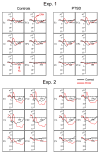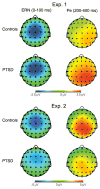Intact error monitoring in combat Veterans with post-traumatic stress disorder
- PMID: 26481979
- PMCID: PMC5645022
- DOI: 10.1016/j.pscychresns.2015.09.016
Intact error monitoring in combat Veterans with post-traumatic stress disorder
Abstract
The error-related negativity (ERN) is a neuroelectric signature of performance monitoring during speeded response time tasks. Previous studies indicate that individuals with anxiety disorders show ERN enhancements that correlate with the degree of clinical symptomology. Less is known about the error monitoring system in post-traumatic stress disorder (PTSD). PTSD is characterized by impairments in the regulation of fear and other emotional responses, as well as deficits in maintaining cognitive control. Here, combat Veterans with PTSD were compared to control Veterans in two different versions of the flanker task (n=13 or 14 per group). Replicating and extending previous findings, PTSD patients showed an intact ERN in both experiments. In addition, task performance and error compensation behavior were intact. Finally, ERN amplitude showed no relationship with self-reported PTSD, depression, or post-concussive symptoms. These results suggest that error monitoring represents a relative strength in PTSD that can dissociate from cognitive control functions that are impaired, such as response inhibition and sustained attention. A healthy awareness of errors in external actions could be leveraged to improve interoceptive awareness of emotional state. The results could have positive implications for PTSD treatments that rely on self-monitoring abilities, such as neurofeedback and mindfulness training.
Keywords: Anterior cingulate cortex; Anxiety; Cognitive control; Error-related negativity; Mild traumatic brain injury; Performance monitoring; Self-monitoring.
Published by Elsevier Ireland Ltd.
Conflict of interest statement
The authors declare they have no conflict of interest.
Figures



Similar articles
-
Neural response to errors in combat-exposed returning veterans with and without post-traumatic stress disorder: a preliminary event-related potential study.Psychiatry Res. 2013 Jul 30;213(1):71-8. doi: 10.1016/j.pscychresns.2013.01.002. Epub 2013 May 17. Psychiatry Res. 2013. PMID: 23684979
-
Discriminative delay Pavlovian eyeblink conditioning in veterans with and without posttraumatic stress disorder.J Anxiety Disord. 2008 Jun;22(5):809-23. doi: 10.1016/j.janxdis.2007.08.009. Epub 2007 Aug 30. J Anxiety Disord. 2008. PMID: 17913453
-
Locus of control in US combat veterans: Unique associations with posttraumatic stress disorder 5-factor model symptom clusters.Psychiatry Res. 2018 Oct;268:152-156. doi: 10.1016/j.psychres.2018.07.015. Epub 2018 Jul 11. Psychiatry Res. 2018. PMID: 30029062
-
A cognitive model of guilt typology in combat-related PTSD.J Trauma Stress. 1994 Jan;7(1):3-19. doi: 10.1007/BF02111908. J Trauma Stress. 1994. PMID: 8044440 Review.
-
Psychophysiological assessment: clinical applications for PTSD.J Affect Disord. 2000 Dec;61(3):225-40. doi: 10.1016/s0165-0327(00)00340-2. J Affect Disord. 2000. PMID: 11163424 Review.
Cited by
-
Flanker task parameters are related to the strength of association between the ERN and anxiety: a meta-analysis.bioRxiv [Preprint]. 2024 Aug 28:2024.08.27.609944. doi: 10.1101/2024.08.27.609944. bioRxiv. 2024. PMID: 39253470 Free PMC article. Preprint.
-
Dissociation between working memory performance and proactive interference control in post-traumatic stress disorder.Neuropsychologia. 2017 Feb;96:111-121. doi: 10.1016/j.neuropsychologia.2017.01.005. Epub 2017 Jan 7. Neuropsychologia. 2017. PMID: 28077328 Free PMC article.
-
The error-related negativity (ERN) moderates the association between interpersonal stress and anxiety symptoms six months later.Int J Psychophysiol. 2020 Jul;153:27-36. doi: 10.1016/j.ijpsycho.2020.03.006. Epub 2020 Apr 8. Int J Psychophysiol. 2020. PMID: 32277956 Free PMC article.
-
The Association Between Experimentally Induced Stress, Performance Monitoring, and Response Inhibition: An Event-Related Potential (ERP) Analysis.Front Hum Neurosci. 2020 Jun 5;14:189. doi: 10.3389/fnhum.2020.00189. eCollection 2020. Front Hum Neurosci. 2020. PMID: 32581742 Free PMC article.
-
Individual differences in combat experiences and error-related brain activity in OEF/OIF/OND veterans.Int J Psychophysiol. 2018 Jul;129:52-57. doi: 10.1016/j.ijpsycho.2018.04.011. Epub 2018 Apr 25. Int J Psychophysiol. 2018. PMID: 29704581 Free PMC article.
References
-
- Aarts K, Vanderhasselt MA, Otte G, Baeken C, Pourtois G. Electrical brain imaging reveals the expression and timing of altered error monitoring functions in major depression. Journal of Abnormal Psychology. 2013;122:939–950. - PubMed
-
- American Psychiatric Association. Diagnostic and statistical manual of mental disorders. 5. Washington, DC: 2013.
-
- Araki T, Kasai K, Yamasue H, Kato N, Kudo N, Ohtani T, Nakagome K, Kirihara K, Yamada H, Abe O, Iwanami A. Association between lower P300 amplitude and smaller anterior cingulate cortex volume in patients with posttraumatic stress disorder: A study of victims of Tokyo subway sarin attack. Neuroimage. 2005;25:43–50. - PubMed
Publication types
MeSH terms
Grants and funding
LinkOut - more resources
Full Text Sources
Other Literature Sources
Medical

